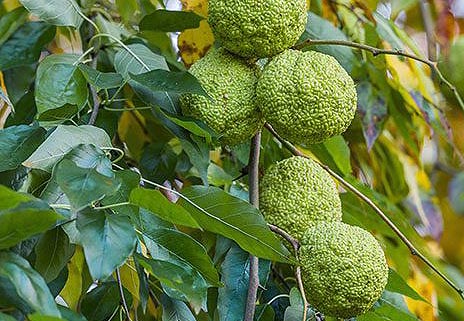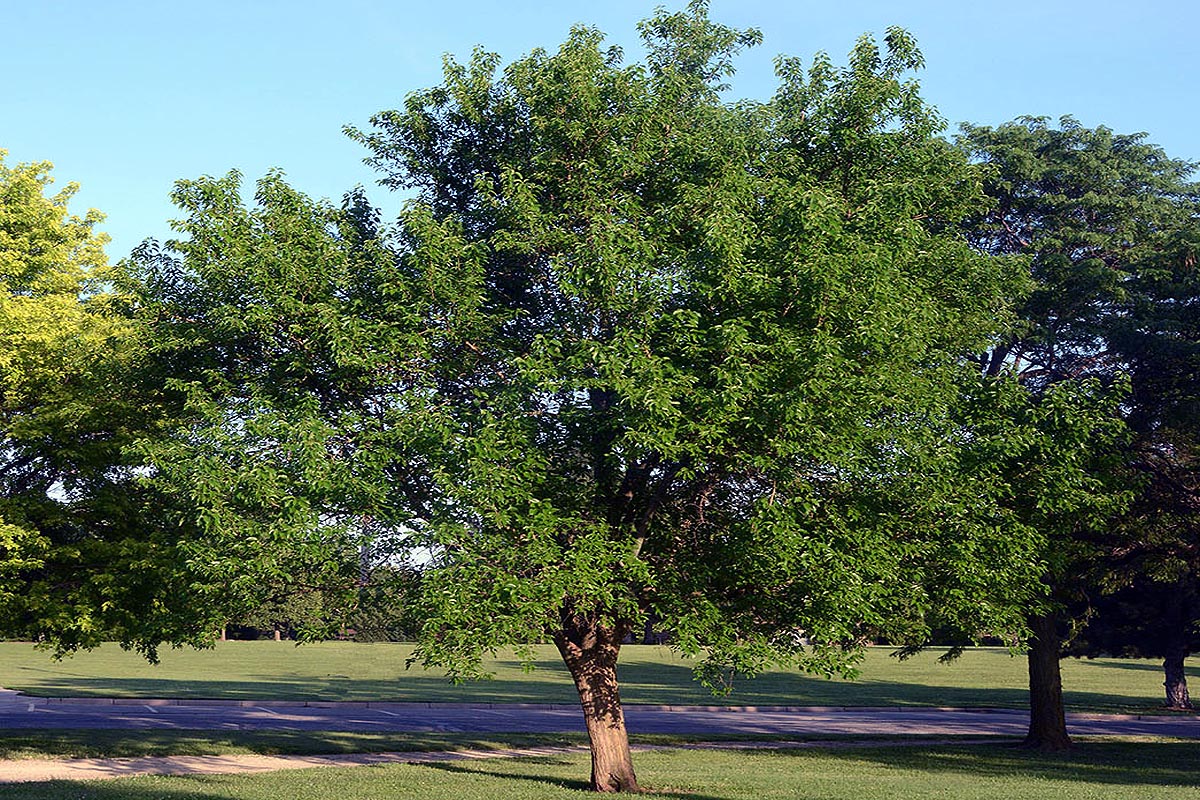Unusual tree with weird looking fruits. The osage orange is not an orange, its related to the mulberry. The large fruits up to 5 inches (13cm) across have many names like hedge apple or monkey brain but I think look more like caulflowers. They do have a slight citrus odor but are not edible. Grows into a medium sized tree around 40 feet (12m) with lots of thorns. Makes a perfect hedge because nothing large can get through it. It was once used to contain cattle and help with soil erosion in the plains states but barbed wire came along and reduced its use. Most home owners dont want barbed wire around their property but an osage orange hedge would do just as well. Seeds do need some stratification before they germinate but its fairly simple in comparison to most other trees. Easy to grow a good number of trees to form a hedge which also helps birds as they love to nest in the protective branches. There are male and female trees so you need both to get fruits. Trees can live a long time so a hedge lasts just as long.
The bark is brown to light orange and only slightly grooved on young trees but older trees develop a much more erratic deeply grooved exterior that still shows something of the original orange color. the wood is a warm orange yellow color, very dense and heavy. It is mostly rot free making it desirable as fence posts. Trees tend to grow multiple trunks that are slightly curved or bent rather than straight.
In some cases the seeds will begin to sprout while still under stratification so having them planted in substrate first is suggested as moving sprouting seedlings without disturbing the proto root can be difficult. If this is damaged the seedling will not grow.
Plant seeds about 3/8" (1cm) deep.
Once stratification is over place seeds in a cool area do not allow temperatures to go above 75 F (25C) or a second dormancy may be triggered and seeds will not germinate. So keep them in cool area with good but not really bright sunshine until germination occurs. When stratification is followed seeds usually germinate within 40-60 days after being removed from cold. Allow seedlings to grow on until they have at least one set of true leaves (not the first two leaves the next set), more if the pot is large enough then carefully transplant to larger deep pot to allow roots to develop well. While you can purchase tree pots cardboard milk or juice cartons work equally as well and make a good recycling use, just ensure you punch a few holes in the bottom for drainage before you plant.
Seedlings are slow to grow, expect to nurture you seedlings for a year, maybe more before they are large enough to be planted outside. Ensure overwintering tree seedlings are kept from freezing. Frozen pots can easily kill a small tree. A garage attached to a home is usually warm enough to sustain them over the winter months. If you have a garage window a flat surface before it will be ideal.
Full sun is the best choice for these trees but they can tolerate a small amount of shade. They are not really fussy about soil type provided it is well drained. Ensure that seedlings have been well hardened off (become used to full sun) before planting or they can become sun scold and this will dramatically inhibit growth.
Water regularly for the first year to ensure that the tiny tree gets the care it needs. Trees usually take at least a year to acclimatize to their new location and get established before they begin to grow strongly. So don't expect too much growth until the second year, Then if the tree is happy in its location is should begin to grow rapidly.
Trees can be planted in isolation as a specimen tree or in rows about 6 feet (1.8m) apart if a hedge is to be created. Remember that several trees will need to be planted if fruits are required as both male and female plants are needed to produce these fruits. Sadly there is no way to determine which is male or female until the flower. For hedge production more males are desirable as it means less fruit clean up.
If planting for a hedge trees will need to be pruned down once they reach about 6 feet (1.8m) to encourage lateral growth and a more bush like habit. Once the plants have thickened to form a hedge they can be left to grow taller until the desired height is reached. Regular pruning and trimming may be needed to control trees planted as a hedge. However the effort is worth it. Nothing gets through a Osage orange hedge except a chain saw.
The seeds themselves are edible and can be roasted. However they take a long time to extract from the fruits so its really not worth the bother.
The dense wood being also pliable has been used since ancient times to make bows. Those made from this wood are considered far superior to any other wood and command a very high price even today. Of course arrows are also fashioned from the wood but it is also used for other small tools as handles, horse collars, parts for saw and grain mills as well as musical instruments. The pliability also made in very desirable for manufacture of wagon wheels.
The wood is a beautiful honey gold color and is much prized by woodworkers for creating all kinds of wooden items and artworks.
The only downside is that the trees don't grow very large and rarely if ever straight so only small pieces of the wood are available for use.
However the wood being so dense is also an excellent fuel source. When dried correctly it can produce long lasting high heat so is desirable in forges and kilns. It is important to dry the wood correctly if not that the heat can become erratic and has been known to produce sparks that can crack chimneys and blow up cast iron stoves.
Osage orange trees yield several dyes, a yellow from the bark root and wood. Green from the fruits.
There are some reports of an insecticide that is effective against cockroaches being made from the fruits.








